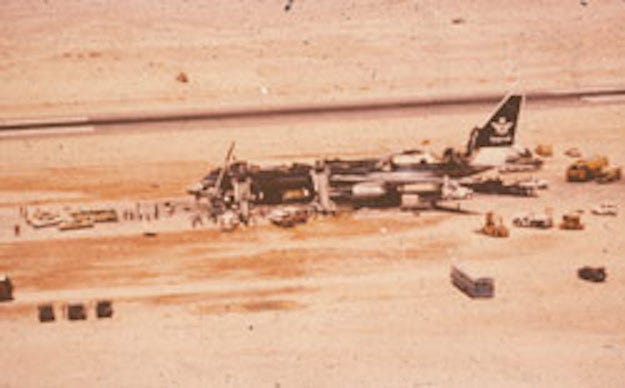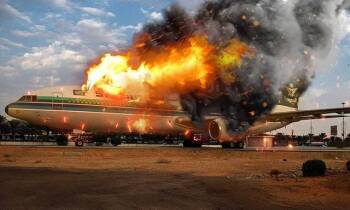On August 19, 1980, Saudia Flight 163 took off from Riyadh International Airport in Saudi Arabia. What seemed like a normal flight started taking a turn for the worst when the crew received warnings of smoke from the cargo compartment. The flight crew declared an emergency and returned to Riyadh, landing 28 minutes after takeoff.

However, as the aircraft stopped at a taxiway, no evacuation was initiated for 26 minutes until ground personnel opened an emergency exit door from outside. Shortly after the door's opening, the aircraft's interior was engulfed by a flash fire, destroying it immediately with the loss of everyone on board. To this date, it remains a mystery why the flight crew did not initiate an evacuation.
Flight Information
Flight 163 was operated with a Lockheed L-1011-200 TriStar with registration HZ-AHK. It first flew on July 13, 1979 and was delivered new to Saudia on August 21 the same year. HZ-AHK was just over one year old at the time of the incident. Flight 163 had 287 passengers and 14 crew members.
The flight crew consisted of three people: the captain, the first officer, and the flight engineer. The captain was 38-year-old Mohammed Ali Al-Khowyter, who had 7,674 hours of flight time, of which 388 hours were in a TriStar. The first officer was 26-year-old Sami Abdullah Hasanain, having 1,615 hours of flight time, of which 125 were in a TriStar. The flight engineer was 42-year-old Bradley Curtis (born Zdzisław Szczęsny), having 650 hours of flight time, of which 157 were in a TriStar.

While all three were certified to fly the TriStar, they were not considered the best pilots for the TriStar. Captain Al-Khowyster was described as a slow-learning pilot and needed more training. First Officer Hasanain was removed from flight school due to poor performance and received his type rating 11 days before the incident. Flight Engineer Curtis did not qualify as a captain or first officer on the Boeing 707 and 737 because he did not meet the requirements and had to pay for his training on the TriStar to keep his job.
The Incident
Flight 163 originated from Quaid-e-Azam International Airport (currently Jinnah International Airport) in Pakistan and stopped at Riyadh International Airport (presently destructed and replaced with King Khalid International Airport). The destination for this flight was Jeddah International Airport.
The TriStar took off from Riyadh at 9:08 p.m. local time. Seven minutes after takeoff, the crew received warnings of smoke from the cargo compartment. Flight engineer Curtis went to the cabin to assess the problem. 11 minutes before landing back at Riyadh, the thrust lever for the number 2 engine on the aircraft's tail became jammed, so that engine was shut down four minutes later.

The flight landed back at Riyadh at 9:36 p.m. local time, 28 minutes after takeoff. The TriStar stopped at a taxiway at the end of the runway two minutes and 40 seconds after touchdown. The fire department was expecting an emergency stop; however, it had to chase the TriStar as it rolled down the end of the runway.
After the aircraft stopped, the crew said they would shut down the engines. However, the engines kept running for another three minutes and 15 seconds, and when the engines shut down, communications with the flight crew were lost. It is reported that flames were visible through the aircraft's rear windows.
At 10:05 p.m., 23 minutes after engine shutdown and 29 minutes after landing, a door on the right side of the aircraft was opened by ground crew. Three minutes later, the interior of the aircraft experienced a flash fire, destroying the aircraft and taking the lives of all onboard.

Investigation
The aircraft was found to be pressurized after landing, contrary to standard procedures. Autopsies conducted on the victims concluded that they perished due to smoke inhalation, not burns, meaning that the victims were incapacitated before the door was opened.
The most mysterious question has yet to be answered: it cannot be determined why the flight crew did not initiate an evacuation of the aircraft. Also, the fire's origin was not found; all that is known is that a fire started in the C3 section in the cargo hold.
While Flight 163 remains a horrible tragedy to this day, there have been changes made to prevent such accidents from happening. Saudia revised its training procedures while Lockheed removed insulation from the rear cargo area, adding glass laminate for reinforcement. The National Transportation Safety Board (NTSB) recommended that aircraft use halomethane fire extinguishers instead of traditional hand-held extinguishers.
Passengers Encounter Bedbug Infestation on Multiple Turkish Airlines Flights » Could You Survive a Plane Crash? The Unlikely Science of Plane Crash Survival » Export Development Canada Secures Aircraft Repossession in Nigeria Under Cape Town Convention »
Comments (0)
Add Your Comment
SHARE
TAGS
STORIES Saudia Saudi Arabia Riyadh Incident History Safety Lockheed Martin TriStar Emergency PilotRECENTLY PUBLISHED
 Could You Survive a Plane Crash? The Unlikely Science of Plane Crash Survival
With air travel consistently being heralded as the safest form of public transport, most of us do not board a plane pondering our chances of survival in the event of a crash. But, is it possible to survive one?
INFORMATIONAL
READ MORE »
Could You Survive a Plane Crash? The Unlikely Science of Plane Crash Survival
With air travel consistently being heralded as the safest form of public transport, most of us do not board a plane pondering our chances of survival in the event of a crash. But, is it possible to survive one?
INFORMATIONAL
READ MORE »
 Maldivian Airlines Introduces First-Ever Widebody Aircraft, Plans New China Flights
Maldivian, the government-owned national airline of the Maldives, has just welcomed its first-ever wide body aircraft: the Airbus A330-200. With the new aircraft, the carrier also plans brand-new long haul international flights to China.
NEWS
READ MORE »
Maldivian Airlines Introduces First-Ever Widebody Aircraft, Plans New China Flights
Maldivian, the government-owned national airline of the Maldives, has just welcomed its first-ever wide body aircraft: the Airbus A330-200. With the new aircraft, the carrier also plans brand-new long haul international flights to China.
NEWS
READ MORE »
 Thousands of Flights Impacted as Winter Storm Blair Hits U.S.
Winter Storm Blair has unleashed a huge blast of snow, ice, and freezing temperatures across the Central and Eastern United States.
As of Sunday afternoon, over 6,700 flights and counting have been disrupted. This includes cancelations and significant delays leaving passengers scrambling to change flights and adjust travel plans.
NEWS
READ MORE »
Thousands of Flights Impacted as Winter Storm Blair Hits U.S.
Winter Storm Blair has unleashed a huge blast of snow, ice, and freezing temperatures across the Central and Eastern United States.
As of Sunday afternoon, over 6,700 flights and counting have been disrupted. This includes cancelations and significant delays leaving passengers scrambling to change flights and adjust travel plans.
NEWS
READ MORE »





